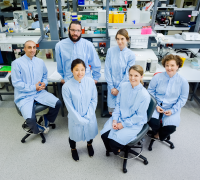Seven patients have been given a new lease on life after receiving a donated kidney as part of Australia’s largest live kidney transplant.
The procedures were conducted under the Australian Paired Kidney Exchange (AKX) program, run by the government’s Organ and Tissue Authority, and with vital assistance from the Australian Red Cross Lifeblood’s Transplantation and Immunogenetics team. During the transplants, specialists from six hospitals across three states performed 14 surgeries at the same time in a carefully coordinated logistical exercise.
“Transplantation is a team sport,” said Rhonda Holdsworth, the National Manager of Transplantation and Immunogenetics Services at the Blood Service, whose teams were the ‘code breakers’ for each of the transplants. “You don’t just have one conductor, you have entire teams, across the country, from different organisations, working together to make this happen.”
The AKX program facilitates live donor kidney transplants by identifying matches for patients who are eligible for a kidney transplant and have a living donor who is willing to donate, but can’t do so because they’re not compatible. When this happens, the recipient and donor’s details are entered into the AKX pool where they’re matched with other donor and recipient pairs in chains to find a suitable swap.
In this record-breaking match run, an altruistic donor— a good Samaritan—kick-started the domino-like seven-way kidney exchange.
For every AKX program match run, held quarterly each year, it’s the Blood Service’s highly specialised transplantation teams who piece the puzzle together and match a donor with their suitable recipient.
“The matching process is a mammoth effort that requires exhaustive testing,” said Rhonda. “A computer system generates, using a range of criteria, a potential match between two compatible pairs. But, with something as complex as a seven-way chain, we need to examine all the matching raw data to ensure immunological compatibility. There are upwards of a 1,000 combinations of different elements that have to be assessed with matching, and it’s our job to figure this out.
“For the AKX to work, each donor and recipient pair needs to be matched with another pair within a chain. It has to be an even swap so even if a donor is easy to match with other recipients, if their recipient is unable to get a match, the exchange won’t go ahead. There are many chain combinations generated and with this way of matching, it really takes us to a whole other level. The complexities are intense.”
While extremely complicated, this type of matching ensures the kidneys are immunologically well matched to achieve a successful transplant.
“We’re not taking out a kidney unless we get the very best outcome,” said Rhonda. “This type and level of matching is world-renowned and unique to Australia and we’re proud to be pushing the boundaries with the state-of-the-art testing services we provide. We’re currently having discussions with our international colleagues about how we can transfer our knowledge from this successful program, to other countries.”
Praising her teams’ efforts, it’s the big picture team work that strikes Rhonda as the most impressive part of this extraordinary story.
“For me, it’s the fact that we’ve pushed the paradigm with the AKX program and we’ve worked outside the square,” she said. “We’ve added another dimension of analysis, beyond our normal day-to-day operations, and we’ve pieced together a big picture puzzle to enable something really amazing.”
Photo: The Blood Service’s Transplantation and Immunogenetics team. Back row, from left: Nikolas Homatopoulos, Scientist; Steven Hiho, Medical Scientist; Laura Bradford, Scientist. Front row, from left: Grace Foo, Medical Scientist; Cathie Hart, Senior Scientist; Linda Cantwell, Senior Scientist.

